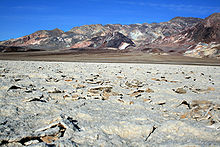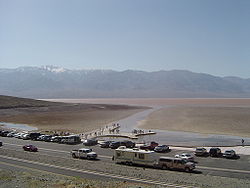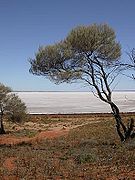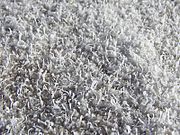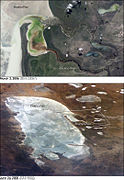- Dry lake
-
"Salt Flat" redirects here. For the settlement, see Salt Flat, Texas.
Dry lakes are ephemeral lakebeds, or a remnant of an endorheic lake. Such flats consist of fine-grained sediments infused with alkali salts. Dry lakes are also referred to as alkali flats, sabkhas, playas or mud flats. If the surface is primarily salt then they are called salt pans, pans, hardpan or salt flats (remnants of salt lakes).
Contents
Terminology
The Spanish word playa (pronounced: [ˈplaʝa]) literally means "beach". Dry lakes are known by this name in some parts of Mexico and the western United States. This term is also used on the Llano Estacado and other parts of the Southern High Plains.
In South America, the usual term for a dry lake is salar, Spanish for "salt pan".
Pan is the term used in most of South Africa. These may include the small round highveld pans, typical of the Chrissiesmeer area, to the extensive pans of the Northern Cape province, which are sometimes employed for land speed record attempts. It is also used in Australia. Distinguished are salt pans and clay pans.
Hardpan is a dry terminus of an internally drained basin in a dry climate, typically used in the Great Basin of the western US.
In Arabic, an alkali flat is called a sabkha (also spelled sabkhah, subkha or sebkha) or shott (chott).
In Central Asia, a similar "cracked mud" salt flat is known as a takyr.
In Iran salt flats are called kavir.
Formation
The rarely-flooded Badwater Basin after the exceptionally wet winter and spring of 2005, Death Valley National Park.
The surface of a dry lake is typically dry, hard and rough during the dry season, but wet and very soft in the rainy season. Dry lakes are generally small, round depressions in the surface of the landscape.
A playa lake is formed when rain fills a round depression in the landscape, creating a small lake. The water is generally freshwater, When all of the water evaporates, a playa is formed. The playa appears as a flat bed of clay, generally encrusted with precipitated salts. These evaporate minerals are a concentration of weathering products that have been left behind. Some examples of evaporite minerals are sodium carbonate, borax, and other salts. Playas are often found in bajadas, a depositional landform of desert environments.[1]
Dry lakes can also form when the water table intersects the surface and water seeps into them.
Dry lakes are typically formed in semi-arid to arid regions of the world. The largest concentration of dry lakes in the world (nearly 22,000) is in the southern High Plains of Texas and eastern New Mexico.[citation needed]
Most dry lakes are small, however Salar de Uyuni in Bolivia, near Potosí, the largest salt flat in the world is of 4,085 square miles (10,582 square km).
Many dry lakes contain shallow water during the rainy season, especially during wet years. If the layer of water is thin and is moved around the dry lake by wind, an exceedingly hard and smooth surface may develop. Thicker layers of water may result in a "cracked-mud" surface and "teepee" structure desiccation features. Very little water can result in dune formation.
Ecology
While the dry lake itself will be devoid of vegetation, they are commonly ringed by shadscale, saltbrush and other salt-tolerant plants that provide critical winter fodder for livestock and other herbivores.
Threats to dry lakes include pollution from concentrated animal feeding operations such as cattle feedlots and dairies, erosion, fertilizer, pesticide and sediment runoff from farms, and overgrazing.
Human use
 The Mosaic Company chemical plant processes brines from Searles Dry Lake to make such products as trona
The Mosaic Company chemical plant processes brines from Searles Dry Lake to make such products as trona
The extremely flat, smooth and hard surfaces of dry lakes make them ideal for motor vehicles and bicycles. Furthermore, large-sized dry lakes are excellent spots for pursuing land speed records, as the smoothness of the surface allows low-clearance vehicles to travel very fast without any risk of disruption by surface irregularities, and the path traveled has no obstacles to avoid. The dry lakes at Bonneville Salt Flats in Utah and Black Rock Desert in Nevada have both been used for setting land speed records. Dry lake beds that do not fill with water at any time are sometimes used as locations for air bases, for similar reasons. Examples include Area 51 in Nevada, and Edwards Air Force Base (originally known as Muroc Dry Lake) in California.
Brines from the subsurface of dry lakes are often exploited for valuable minerals in solution. See, for example Searles Dry Lake and Lithium resources.
United States regulation
Under United States law, a "playa lake" may be considered isolated wetlands, and may be eligible to enroll in the new wetlands component of the Conservation Reserve Program, enacted in the 2002 farm bill (P.L. 107-171, Sec. 2101).[2]
Gallery
-
The dry lake and shore of Lake Hart, an endorheic desert lake in South Australia. -
Salt harvesting in Salar de Uyuni, Bolivia, the world's largest salt flat. -
Etosha Pan in northern Namibia
See also
References
- ^ Grotzinger, John, Thomas H. Jordan, Frank Press and Raymond Siever; Understanding Earth, Freeman, 5th Ed., 2006, ISBN 978-0716766827
- ^ "CRS Report for Congress: Agriculture: A Glossary of Terms, Programs, and Laws, 2005 Edition - Order Code 97-905". http://ncseonline.org/nle/crsreports/05jun/97-905.pdf. Retrieved November 30, 2009. "A temporary lake created in the lowest elevation of a basin in an arid area that has no surface drain into another water body, such as a perennial stream or river. Lake water is removed either by evaporation into the air or seepage into the ground."
Bibliography
- Briere, Peter R. (May 2002). "Playa, playa lake, sabkha: Proposed definitions for old terms". Journal of Arid Environments (Elsevier) 45 (1): 1–7. doi:10.1006/jare.2000.0633.
- John H. Wellington, "Southern Africa: a geographical study", Chapter 16 LAKES AND PANS
Categories:- Salt flats
- Spanish loanwords
- Aeolian landforms
- Fluvial landforms
-
Wikimedia Foundation. 2010.

